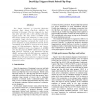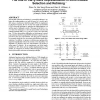285 search results - page 11 / 57 » A Comparison of Two Architectural Power Models |
ALT
2004
Springer
14 years 6 months ago
2004
Springer
Different formal learning models address different aspects of learning. Below we compare learning via queries—interpreting learning as a one-shot process in which the learner i...
VLSID
2005
IEEE
14 years 10 months ago
2005
IEEE
Two Simple structures of low-power Dual-edge triggered Static Pulsed Flip-Flops (DSPFF) are presented in this paper. They are composed of a dualedge pulse generator and a static f...
MOMPES
2008
IEEE
14 years 4 months ago
2008
IEEE
During its lifetime, embedded systems go through multiple changes to their runtime architecture. That is, threads, processes, and processor are added or removed to/from the softwa...
DSD
2009
IEEE
14 years 1 months ago
2009
IEEE
—Duplication and comparison has proven to be an efficient method for error detection. Based on this generic principle dual core processor architectures with output comparison ar...
DAC
2000
ACM
14 years 11 months ago
2000
ACM
Joint module selection and retiming is a powerful technique to optimize the implementation cost and the speed of a circuit specified using a synchronous data-flow graph (DFG). In ...


